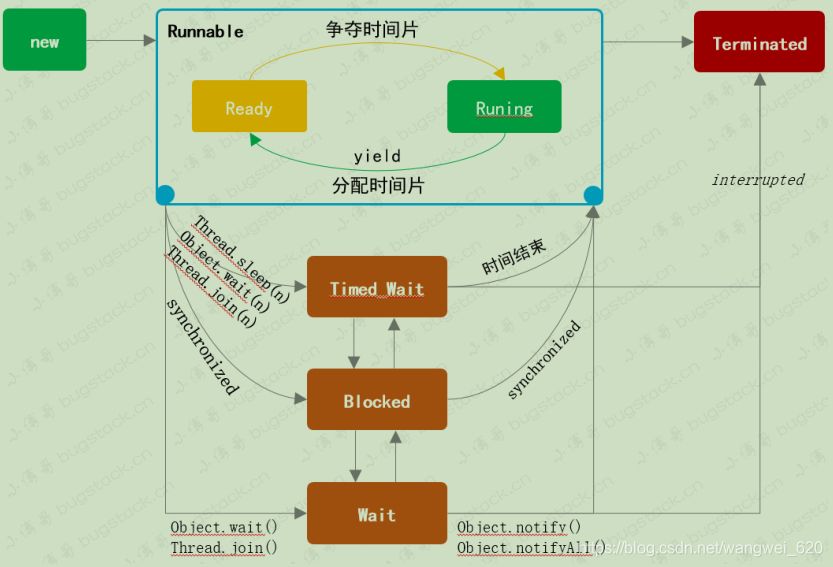Thread、线程状态转化、方法使用
一、Thread状态关系
java 的线程的状态在Thread.state的枚举类中
public enum State {
NEW,
RUNNABLE,
BLOCKED,
WAITING,
TIMED_WAITING,
TERMINATED;
}
这五种状态的描述了一个线程的生命周期,其他状态的定义在我们的业务开发中,也经常出现,比如:一个活动的提交、审核、拒绝、修改、通过、运行、关闭等类似的,线程通过如下图片进行流转。



二、状态测试
1、NEW
Thread thread = new Thread(()->{
});
System.out.println(thread.getState());
new状态是线程创建还没有启动。
2、Runnable
Thread thread = new Thread(()->{
});
//启动
thread.start();
System.out.println(thread.getState());
线程启动后start,就会进入RUnnable状态,但是此时并不一定执行,而是这个线程已经准备就绪了,可以竞争CPU资源。
3、Blocked
Object o = new Object();
new Thread(()->{
synchronized (o){
try {
Thread.sleep(10000);
}catch (Exception e){
e.printStackTrace();
}
}
}).start();
Thread thread = new Thread(()->{
synchronized (o){
try {
o.wait();
}catch (Exception e){
e.printStackTrace();
}
}
});
thread.start();
while (true){
try{
Thread.sleep(1000);
}catch (Exception e){
e.printStackTrace();
}
System.out.println(thread.getState());
}
主要是为了让两个线程发生锁竞争
第一个synchronized获取锁后休眠
第二个synchronized获取不到锁,会被挂起
随后输出的结果都是Blocked
4、Waiting
Object obj = new Object();
Thread thread = new Thread(() -> {
synchronized (obj) {
try {
obj.wait();
} catch (Exception e) {
e.printStackTrace();
}
}
});
thread.start();
while (true) {
try {
Thread.sleep(1000);
} catch (Exception e) {
e.printStackTrace();
}
System.out.println(thread.getState());
}
5、TIMED_WAITING
Object object = new Object();
Thread thread = new Thread(()->{
synchronized (object){
try{
Thread.sleep(100000);
}catch (Exception e){
e.printStackTrace();
}
}
});
thread.start();
while (true){
try {
Thread.sleep(1000);
}catch (Exception e){
e.printStackTrace();
}
System.out.println(thread.getState());
}
6、TERMINATED
Thread thread = new Thread(()->{
});
thread.start();
System.out.println(thread.getState());
System.out.println(thread.getState());
System.out.println(thread.getState());
方法执行完,就进入terminated
三、Thread方法使用
一般情况下,Thread的最常用的start启动,除此之外一些其他的方法,使用不多,但是却在框架中可以看到,包括:yield、wait、notify、join
1、yield
yield方法让出CPU,但是不一定,一定让出,这样可能在一些同时启动的线程中,按照优先级保证线程的执行,也可以是一些特殊的场景,例如:这个线程很耗时,但又不重要,可以放到后面。
验证这个方法,启动50个线程,每个线程都进行1000次的加和运算,其中10个线程会执行让出CPU执行操作,如果让CPU那10个计算加和时间比较长,说明确实存在让出操作。
/**
* @Author: wangwei
* @Date: 2021/6/17 21:27
* @Version: 1.0
* @Description:
*/
public class TestYield {
private static volatile Map<String, AtomicInteger> count = new ConcurrentHashMap<>();
static class Y implements Runnable{
private String name;
private Boolean isYeild;
public Y(String name,Boolean isYeild){
this.name = name;
this.isYeild = isYeild;
}
@Override
public void run() {
long l = System.currentTimeMillis();
for (int i = 0; i < 1000; i++) {
if (isYeild) Thread.yield();
AtomicInteger atomicInteger = count.get(name);
if (null == atomicInteger){
count.put(name, new AtomicInteger(1));
continue;
}
atomicInteger.addAndGet(1);
count.put(name,atomicInteger);
}
System.out.println("线程编号:"+name+"执行时间耗时:"+(System.currentTimeMillis() - 1)
+" (毫秒)"+(isYeild ? "让出CPU。。。。。。。。。。。。":"不让出CPU"));
}
}
public static void main(String[] args) {
for (int i = 0; i < 50; i++) {
if (i < 10 ){
new Thread(new Y(String.valueOf(i),true)).start();
continue;
}
new Thread(new Y(String.valueOf(i),false)).start();
}
}
}
2、wait & notify
wait 和notify notifyall是一对方法,有一个等待,就会有个唤醒,否则程序就是夯住不动了。
3、join
join是将两个线程合并吗,不是的。
join是让线程进入wait,当线程执行完毕后,会在JVM源码中找到,它执行完毕后,其实就是执行notify,也就是等待和叫醒的操作。
public class TestJoin {
public static void main(String[] args) throws InterruptedException {
Thread thread = new Thread(()->{
System.out.println("thread before");
try{
Thread.sleep(1000);
}catch (Exception e){
e.printStackTrace();
}
System.out.println("thread after");
});
thread.start();
System.out.println("main begin");
thread.join();
System.out.println("main end!");
}
}























 3649
3649











 被折叠的 条评论
为什么被折叠?
被折叠的 条评论
为什么被折叠?










